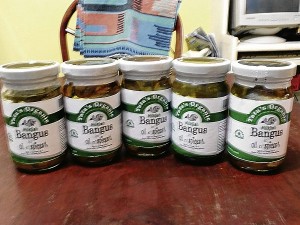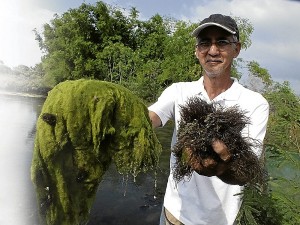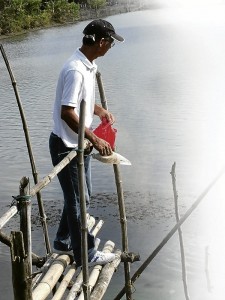Selling ‘bangus’ the way it’s supposed to be grown

DAGUPAN CITY – This Pangasinan city may have conquered the culinary world with its tasty “bangus” (milkfish), but a marine biologist hopes to conquer another market with what he is raising in his fishpond: organic bangus.
Robert Garcia, 57, studies the bangus culture industry and sees the environmental degradation in fishpond areas as a result of the excessive use of commercial feed.
He also discovers that the bulk of farmers’ earnings goes to buying fish feed, leaving them little for their families’ needs.
“There must be a way to culture the national fish with lesser expenses and at the same time conserving the environment,” he says.
In 2004, Garcia, who holds a master’s degree in Marine Biology from the University of the Philippines, acquired a one-hectare fishpond in Barangay Bonuan here to experiment with what he had been teaching in fishery conservation.
He started looking into the possibility of going organic, which would require smaller capital because inputs, like fish feed, are all natural.
But growing organic bangus has its challenges, he says.
‘Lablab’

For instance, he has to grow and wait for the “lablab” (algae) to flourish for a month before he could stock the ponds with fingerlings. But no matter how abundant, lablab is enough to feed the bangus only up to two months.
Garcia says some bangus growers feed their fingerlings algae but they would resort to commercial feed after the stock is consumed.
“But using commercial feed in combination with natural feed would not strictly qualify the fish as organically grown,” he says.
To produce authentic organic bangus, Garcia formulates his own feed using organic raw materials, such as gracilaria (a kind of algae), to replenish the supply of natural feed.
“Bangus grown with natural feed have less fat and leaner meat, making it a healthier option. It also tastes better,” he says.
But the downside in using organic feed is its limited production. “I can only culture between 1,000 and 1,500 bangus per hectare, [which is] way below the commercial production of 10,000 or more per hectare,” he says.
“It is also labor intensive because you have to grow the algae and formulate the organic feed, as compared to commercial bangus farming in which you only have to toss the feed into the pond,” he says.
Organic bangus also requires a longer culture period. While bangus fed with commercial feed can be harvested in four months (depending on the size of fingerlings), it takes at least five months before organic bangus can reach marketable sizes, Garcia says.

A grower also faces the problem of marketing this variety of milkfish, especially to locals.
“There is no consciousness yet as regards the benefits of organic fish among Pangasinenses. Many of them would say, ‘Pareho din ‘yan [It’s the same].’ So I usually bring the [harvest] to Metro Manila,” he says.
He adds older fish growers in the city would share him stories about how they fed their bangus solely with lablab.
Sweet aroma
They say the fish would emit a sweet aroma when grilled and have a distinct flavor that became the trademark of the Dagupan bangus.
“But the locally grown fish now is not much different from those grown elsewhere because of commercial feed,” he says.
“Farmers resorted to commercial culture because of convenience and the prospect of a bigger harvest within a shorter period … There is a need to produce more fish because there is increasing demand and competition from other bangus-producing areas in Pangasinan and other provinces,” he says.
Production cost
While commercial fish farmers harvest huge volumes of bangus, their production cost is also big because of commercial feed, Garcia explains.
The mortality rate is also high because of high stocking density, which is sometimes beyond the pond’s carrying capacity, he adds.
He cites a niche for organically grown bangus, especially among the health-conscious consumers.
Organically grown bangus may command higher prices, but Garcia continues to sell his produce at P80 to P100 a kilogram, the same price range for commercially grown bangus.
Aside from selling fresh bangus, he has started offering bottled bangus (at P75 each) and boneless and “daing” bangus (P90 per pack of three).
But his efforts, Garcia says, are not geared toward raking in huge profits. “I’m not really a businessman. I’m a technical man who wants to help in environmental conservation through my knowledge,” he says.
photos by Yolanda Sotelo, Inquirer Northern Luzon